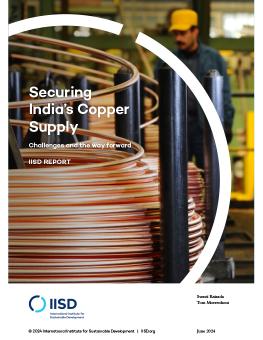
Securing India's Copper Supply
Challenges and the way forward
India's burgeoning infrastructure—spanning from building construction to expanding transportation networks and power grids—is predicated upon a steady supply of copper. Copper is also the lifeblood of new clean energy technologies such as electric vehicles, electric motors, wind turbines, solar panels, and battery storage, all of which are indispensable to the economic, industrial, and sustainable growth that India envisions for itself.
-
India's #cleanenergy #transition and #infrastructure development could double its copper demand by the end of this decade. Ensuring a steady supply of #copper needs a comprehensive #sourcing #strategy.
-
India should #diversify and forge #strategic partnerships with key copper ore and concentrate supplier countries in the short-term while supporting #exploration and #sustainablemining domestically.
-
India's #copper scrap plays a critical role in meeting its domestic copper requirement but GST on scrap remains #high. Given copper's high recyclability, the government should #rationalize the tax structure on scrap to incentivize a circular economy model.
India's economic growth sprint sets the stage to deliberate and forge a comprehensive copper strategy within its overall critical mineral policy. With the intent of providing a starting point for this strategy, this policy brief focuses on the rationale, objectives, and actions needed to secure India’s copper supply.
This policy brief emphasizes the need for India to develop a comprehensive copper strategy. We recommend the following policy options to secure India’s copper supply:
- Secure and diversify India’s primary copper supply: Diversify and forge strategic partnerships with key copper ore and concentrate supplier countries, such as Chile, Peru, Australia, the Democratic Republic of the Congo, and Zambia, amid rising geopolitical risks while supporting exploration and sustainable mining domestically.
- Evaluate the need for trade reforms to promote the extent of domestic value addition: Urgently conduct a full assessment of the impact of India’s trade agreements with its major trade partners for copper products, including the need to extend countervailing duties that are set to expire starting in 2025. Also, assess the costs and benefits of reducing the custom duty on copper ore and concentrate to support the domestic smelting and refining industry and encourage domestic value addition.
- Incentivize the domestic copper smelting, refining, and fabrication industry to meet circularity goals: Incentivize domestic copper smelters, refiners, and fabricators through capital or production-linked incentives while linking incentives to targets on material efficiency, recently issued copper quality standards, and circularity to better utilize scrap available in the country.
- Rationalize the Goods and Services Tax structure for copper scrap: Rationalize the Goods and Services Tax structure on copper scrap by lowering the rate or bringing it under the Reverse Charge Mechanism to incentivize tax compliance within the recycling industry and support the formalization of the unorganized scrap sector.
Participating experts
You might also be interested in
Lithium-Sourcing Roadmap for India
This report aims to provide a strategy to guide policy-makers in sourcing lithium responsibly to promote clean energy manufacturing in India, with the broader aim of supporting low-carbon economic growth, creating equitable jobs, and helping to mitigate climate change impacts.
India's Potential in the Midstream of Battery Production
This report summarizes consultations with over 25 companies and actors to determine what factors are crucial in the considerations of companies on where to invest in and expand battery cell manufacturing.
Agreement on Climate Change, Trade and Sustainability: A landmark pact for trade and sustainability
The ACCTS pact, signed by Costa Rica, Iceland, New Zealand, and Switzerland, aligns trade and environmental policies, tackling fossil fuel subsidies, eco-labels, and green trade.
December 2024 | Carbon Minefields Oil and Gas Exploration Monitor
In November 2024, 23 oil and gas exploration licences were awarded across five countries, with Russia granting the licences that account for the largest portion of embodied emissions.